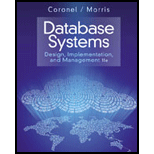
UNION set operator:
The UNION set operator is used to combine the output of two or more than two queries and produce a result. The produced result contains unique values.
Syntax: QUERY UNION QUERY;
INTERSECT set operator:
The INTERSECT set operator is used to combine the output of two or more than two queries and produce a result. The produced result contains the values (rows) that are common in both the tables.
Syntax: QUERY INTERSECT QUERY;
MINUS set operator:
The MINUS set operator is used to combine the output of two or more than two queries and produce a result. The produced result contains the values (rows) that appear in the first table but not in the second table. The word “EXCEPT” can also be used in the place of “MINUS”.
Syntax: QUERY MINUS QUERY;
Want to see the full answer?
Check out a sample textbook solution
Chapter 8 Solutions
Database Systems: Design, Implementation, & Management
- whats for dinner? pleasearrow_forwardConsider the follow program that prints a page number on the left or right side of a page. Define and use a new function, isEven, that returns a Boolean to make the condition in the if statement easier to understand. ef main() : page = int(input("Enter page number: ")) if page % 2 == 0 : print(page) else : print("%60d" % page) main()arrow_forwardWhat is the correct python code for the function def countWords(string) that will return a count of all the words in the string string of workds that are separated by spaces.arrow_forward
- Consider the following program that counts the number of spaces in a user-supplied string. Modify the program to define and use a function, countSpaces, instead. def main() : userInput = input("Enter a string: ") spaces = 0 for char in userInput : if char == " " : spaces = spaces + 1 print(spaces) main()arrow_forwardWhat is the python code for the function def readFloat(prompt) that displays the prompt string, followed by a space, reads a floating-point number in, and returns it. Here is a typical usage: salary = readFloat("Please enter your salary:") percentageRaise = readFloat("What percentage raise would you like?")arrow_forwardassume python does not define count method that can be applied to a string to determine the number of occurances of a character within a string. Implement the function numChars that takes a string and a character as arguments and determined and returns how many occurances of the given character occur withing the given stringarrow_forward
- Consider the ER diagram of online sales system above. Based on the diagram answer the questions below, a) Based on the ER Diagram, determine the Foreign Key in the Product Table. Just mention the name of the attribute that could be the Foreign Key. b) Mention the relationship between the Order and Customer Entities. You can use the following: 1:1, 1:M, M:1, 0:1, 1:0, M:0, 0:M c) Is there a direct relationship that exists between Store and Customer entities? Answer Yes/No? d) Which of the 4 Entities mention in the diagram can have a recursive relationship? e) If a new entity Order_Details is introduced, will it be a strong entity or weak entity? If it is a weak entity, then mention its type?arrow_forwardNo aiarrow_forwardGiven the dependency diagram of attributes {C1,C2,C3,C4,C5) in a table shown in the following figure, (the primary key attributes are underlined)arrow_forward
- What are 3 design techniques that enable data representations to be effective and engaging? What are some usability considerations when designing data representations? Provide examples or use cases from your professional experience.arrow_forward2D array, Passing Arrays to Methods, Returning an Array from a Method (Ch8) 2. Read-And-Analyze: Given the code below, answer the following questions. 2 1 import java.util.Scanner; 3 public class Array2DPractice { 4 5 6 7 8 9 10 11 12 13 14 15 16 public static void main(String args[]) { 17 } 18 // Get an array from the user int[][] m = getArray(); // Display array elements System.out.println("You provided the following array "+ java.util.Arrays.deepToString(m)); // Display array characteristics int[] r = findCharacteristics(m); System.out.println("The minimum value is: " + r[0]); System.out.println("The maximum value is: " + r[1]); System.out.println("The average is: " + r[2] * 1.0/(m.length * m[0].length)); 19 // Create an array from user input public static int[][] getArray() { 20 21 PASSTR2222322222222222 222323 F F F F 44 // Create a Scanner to read user input Scanner input = new Scanner(System.in); // Ask user to input a number, and grab that number with the Scanner…arrow_forwardGiven the dependency diagram of attributes C1,C2,C3,C4,C5 in a table shown in the following figure, the primary key attributes are underlined Make a database with multiple tables from attributes as shown above that are in 3NF, showing PK, non-key attributes, and FK for each table? Assume the tables are already in 1NF. Hint: 3 tables will result after deducing 1NF -> 2NF -> 3NFarrow_forward
 A Guide to SQLComputer ScienceISBN:9781111527273Author:Philip J. PrattPublisher:Course Technology Ptr
A Guide to SQLComputer ScienceISBN:9781111527273Author:Philip J. PrattPublisher:Course Technology Ptr
 Programming with Microsoft Visual Basic 2017Computer ScienceISBN:9781337102124Author:Diane ZakPublisher:Cengage Learning
Programming with Microsoft Visual Basic 2017Computer ScienceISBN:9781337102124Author:Diane ZakPublisher:Cengage Learning- Np Ms Office 365/Excel 2016 I NtermedComputer ScienceISBN:9781337508841Author:CareyPublisher:Cengage
 Database Systems: Design, Implementation, & Manag...Computer ScienceISBN:9781305627482Author:Carlos Coronel, Steven MorrisPublisher:Cengage Learning
Database Systems: Design, Implementation, & Manag...Computer ScienceISBN:9781305627482Author:Carlos Coronel, Steven MorrisPublisher:Cengage Learning Database Systems: Design, Implementation, & Manag...Computer ScienceISBN:9781285196145Author:Steven, Steven Morris, Carlos Coronel, Carlos, Coronel, Carlos; Morris, Carlos Coronel and Steven Morris, Carlos Coronel; Steven Morris, Steven Morris; Carlos CoronelPublisher:Cengage Learning
Database Systems: Design, Implementation, & Manag...Computer ScienceISBN:9781285196145Author:Steven, Steven Morris, Carlos Coronel, Carlos, Coronel, Carlos; Morris, Carlos Coronel and Steven Morris, Carlos Coronel; Steven Morris, Steven Morris; Carlos CoronelPublisher:Cengage Learning





